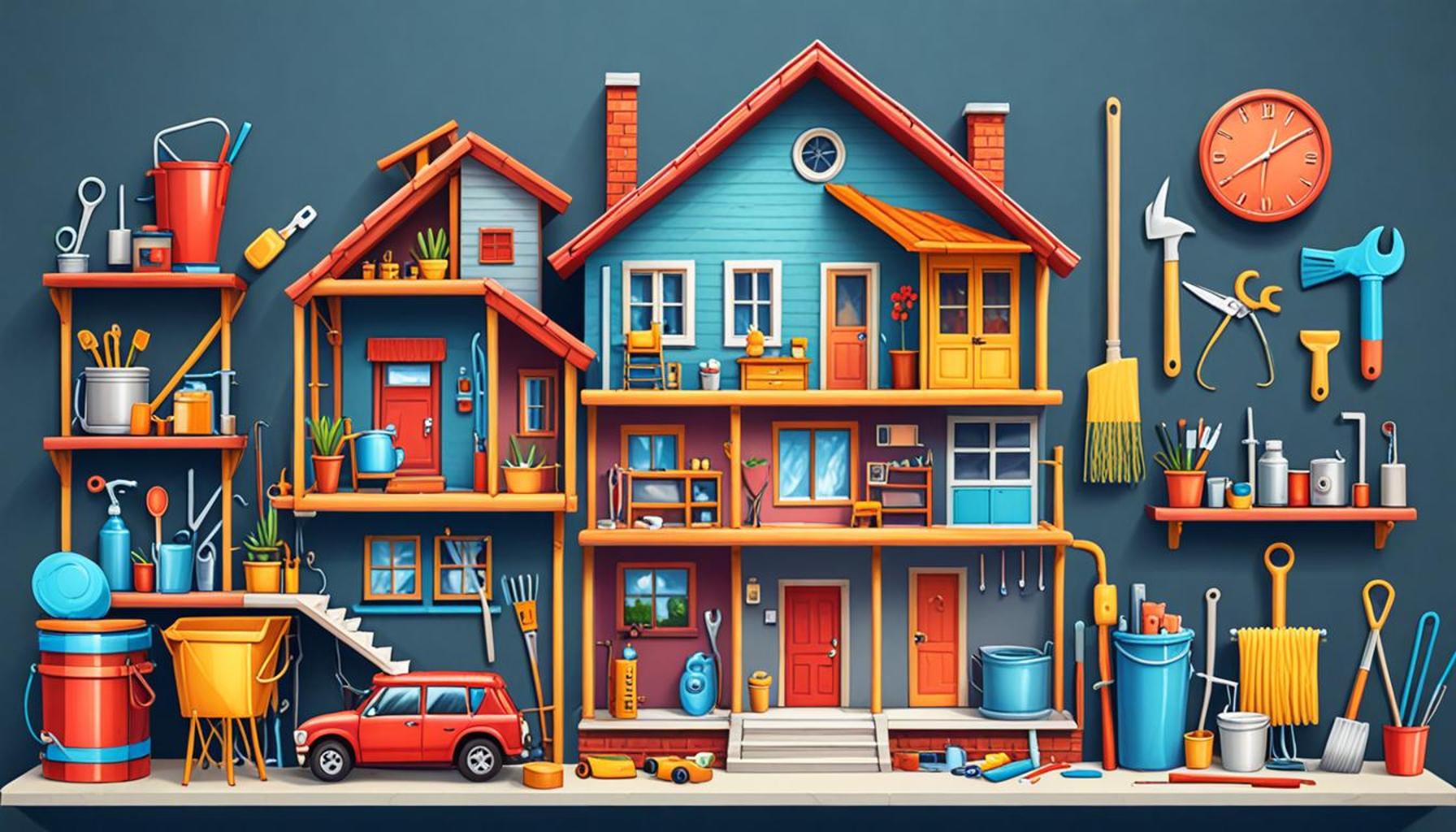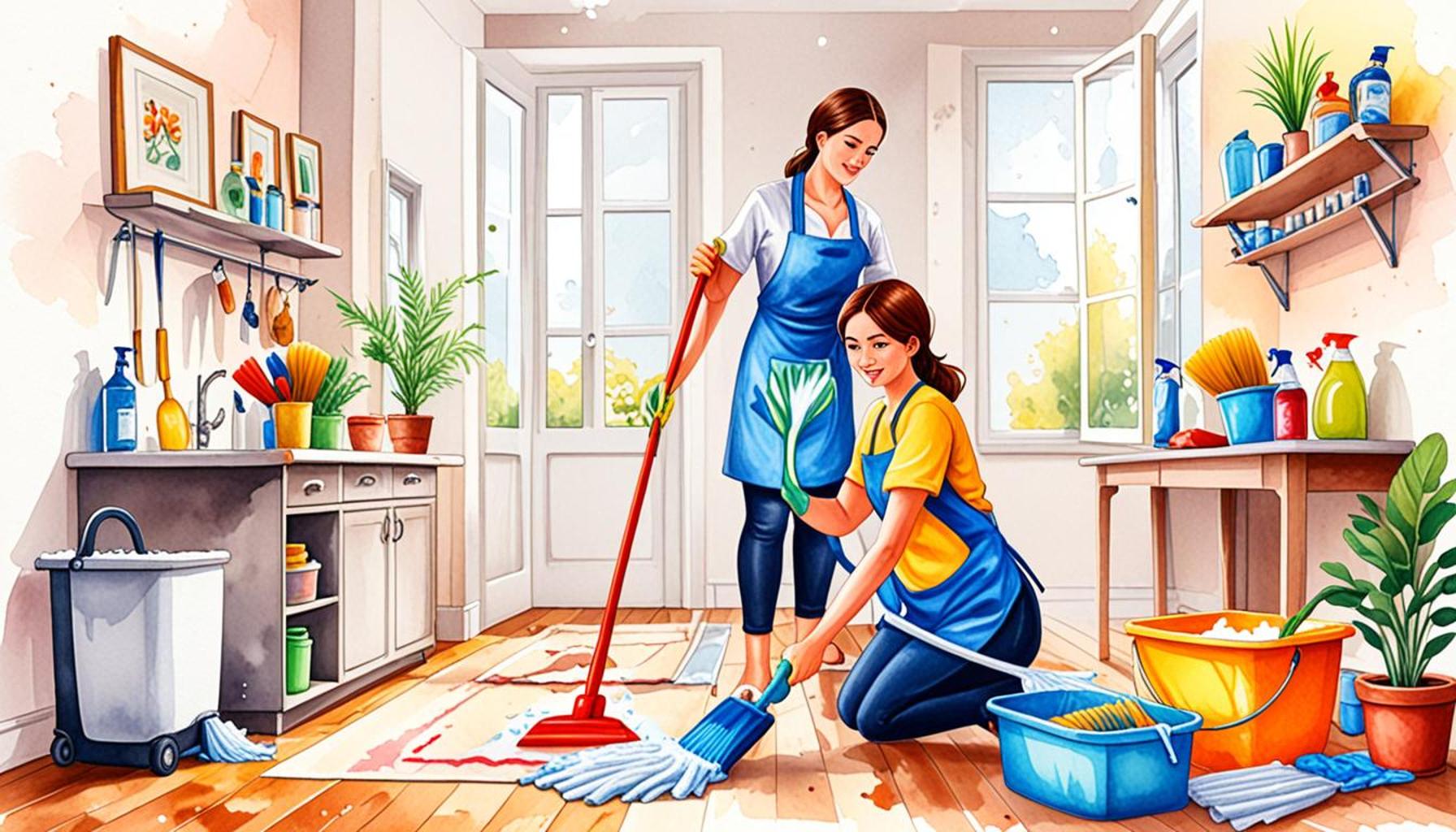The importance of defining priorities in household maintenance tasks

Prioritizing Household Maintenance Tasks for a Stress-Free Home
Managing a household can often feel like juggling multiple balls in the air. With a myriad of maintenance tasks awaiting attention, it’s essential to understand how to define priorities effectively. Not only does this streamline your effort, but it also enhances the overall functionality and comfort of your home.
Consider the various aspects of household maintenance:
- Routine cleaning and organization
- Seasonal maintenance tasks
- Emergency repairs
- Improvements and upgrades
Each category requires a different level of attention. For instance, routine cleaning and organization tasks like vacuuming, dusting, or decluttering can help maintain a pleasant living environment. These tasks may seem less urgent, but they play a crucial role in preventing larger problems, such as pest infestations or mold growth, if neglected over time.
On the other hand, seasonal maintenance tasks such as gutter cleaning or HVAC system checks should be scheduled proactively throughout the year. For example, the fall is an excellent time to check your heating system in preparation for colder months, while spring typically requires checks on your home’s exterior and landscape to ensure everything is ready for the warmer weather.
Perhaps the most critical category of all is emergency repairs. Issues like water leaks, roof damage, or electrical failures can escalate quickly, causing extensive damage and leading to costly repairs. Prioritizing these emergencies can be the difference between a minor fix and a major restoration project. For example, a small plumbing leak can lead to significant water damage if not addressed promptly. Homeowners should always have a trusted repair service on hand to handle these unexpected situations effectively.

Finally, improvements and upgrades enhance the home, adding both aesthetic appeal and value. Projects such as kitchen remodels or landscaping enhancements can improve both functionality and curb appeal but often require careful planning and budgeting. Recognizing the right time to pursue these projects, perhaps during slower maintenance seasons, is essential.
Establishing a clear priority system not only aids in managing your time effectively but also helps to maintain your home’s value. By recognizing which tasks need immediate attention and which can wait, homeowners can create a manageable schedule that fosters consistent upkeep and prevents overwhelming backlogs. Consistency in tackling maintenance tasks is key; aim to allocate specific times during your week or month for various categories to foster a balanced approach.
Ultimately, taking the time to evaluate and rank household maintenance tasks can lead to a more organized home and a less stressed homeowner. Are you ready to dive deeper into the art of prioritizing household chores? By doing so, you promote a healthier, safer living environment that everyone can enjoy.
DISCOVER: Click here for an effective cleaning schedule
Understanding the Layers of Household Maintenance
To effectively manage household maintenance tasks, it’s vital to understand the layers involved in maintaining a home. As a homeowner, you’re not just responsible for keeping your space clean; you must also ensure that various systems within your home remain functional and safe. Recognizing and prioritizing these tasks can prevent larger issues and save not only time but also money in the long run.
One of the first steps in defining priorities is to assess the urgency and importance of various tasks. Here is a breakdown of factors to consider:
- Safety Risks: Tasks that pose immediate safety hazards should be at the top of your priority list. For instance, frayed electrical wiring or a leaking gas line can lead to dangerous situations. Addressing these issues promptly can avert accidents and protect your family.
- Potential Damage: Next, consider tasks that could lead to significant damage if left unattended. For example, ignoring a small crack in the foundation might lead to serious structural issues over time. Small leaks can turn into substantial problems; hence, addressing them without delay is essential.
- Time Sensitivity: Some tasks have better outcomes when completed within a certain timeframe. For example, cleaning your gutters before heavy rain season ensures proper drainage and prevents water damage to your property.
- Personal Needs: Factor in your family’s unique needs and schedules. If you have children, keeping areas free of clutter or maintaining a clean kitchen can contribute to a healthier and more efficient living environment.
Understanding these categories allows homeowners to develop a more structured approach to maintenance. Creating a checklist based on this tiered system can provide clarity and further streamline the process. For instance, a prioritized checklist might look something like this:
- Immediate Safety Risks (e.g., electrical issues, gas leaks)
- Urgent Repairs (e.g., leaking roofs, plumbing issues)
- Seasonal Maintenance (e.g., HVAC checking, pool cleaning)
- Long-term Improvements (e.g., remodeling projects, upgrading appliances)
By categorizing tasks in this way, you can easily visualize what requires immediate attention and what can be scheduled for later. This proactive approach orders the plethora of tasks into a clear hierarchy, helping you tackle the most critical issues first.
Moreover, keeping an eye on prioritization eases the burden of overwhelming maintenance schedules and minimizes the tendency for procrastination. Additionally, regular assessment of priorities throughout the year can ensure that household maintenance evolves alongside the ever-changing needs of your home and family. As you learn the rhythms of your home, you’ll find that a well-maintained space not only functions better but also contributes to a stress-free living environment.
Ultimately, embracing a strategy for defining and prioritizing household maintenance tasks can pave the way for a smoother management process, allowing homeowners to enjoy the sanctity of their home without the looming weight of neglected responsibilities.
The Importance of Prioritizing Household Maintenance Tasks
Prioritizing household maintenance tasks is essential for maintaining a safe and organized home environment. By strategically identifying which tasks require immediate attention, homeowners can effectively manage their time and resources. This not only leads to improved efficiency but also significantly reduces the risk of costly repairs down the line. For example, addressing a minor plumbing leak promptly can prevent extensive water damage that could necessitate the replacement of flooring or cabinetry.When homeowners take the initiative to prioritize tasks, they also ensure that their living space remains both functional and aesthetically pleasing. Regular upkeep such as cleaning gutters, changing air filters, and checking smoke detectors may seem trivial, yet these tasks protect the household from major issues and provide peace of mind. It is crucial to develop a maintenance schedule that encompasses both routine chores and seasonal tasks, streamlining the overall household management process.Moreover, implementing a priority system can lead to increased home value. Properties that are well-maintained tend to attract higher offers during sale negotiations. With a clear understanding of which repairs and improvements are necessary, homeowners are empowered to make informed decisions that will enhance both comfort and resale potential. To illustrate the advantages of this approach further, consider this informative table detailing key benefits associated with defining priorities in household maintenance tasks:
| Category | Benefits |
|---|---|
| Cost Efficiency | Prevent major repairs. |
| Time Management | Organizes tasks effectively. |
| Enhanced Safety | Reduces hazards. |
| Increase Home Value | Attracts better offers. |
In conclusion, understanding and implementing a priorities system in household maintenance tasks not only leads to a harmonious living environment but also ensures safety, efficiency, and increased property value. Clearly identifying and addressing these tasks creates a more enjoyable and secure home life, demonstrating the undeniable value of prioritization.
DON’T MISS OUT: Click here to discover more
Strategies for Effective Prioritization
Having established a framework for categorizing household maintenance tasks, the next step is to delve into strategies that can aid homeowners in efficiently outlining their priorities. Implementing these strategies can transform your approach to home maintenance, making it not only more manageable but also far less time-consuming.
Create a Maintenance Calendar
One effective way to maintain control over household tasks is by creating a detailed maintenance calendar. This calendar should highlight both routine and seasonal maintenance needs, allowing you to allocate specific time slots for each task. For instance, schedule HVAC inspections ahead of summer and winter seasons to ensure peak efficiency of your system. According to the U.S. Department of Energy, regular maintenance can improve system efficiency by 5-15%, reducing your energy bills in the long run.
Use Technology to Your Advantage
In the digital age, there are many apps and software that can assist with home maintenance management. Applications like HomeZada, TaskRabbit, or even Google Calendar allow you to set reminders for tasks based on their categories and priorities. By utilizing technology, homeowners can receive timely notifications, ensuring that no task gets overlooked. Recent data shows that using task management tools can increase productivity by up to 40%, translating to more effective household management.
Engage the Family
Household maintenance should not fall solely on one person. Engaging family members in the prioritization process can not only distribute the workload but also foster a sense of responsibility. Conduct regular family meetings to discuss ongoing home projects and delegate tasks according to each person’s strengths and availability. Research indicates that a collaborative environment increases household efficiency and enhances family bonds, turning mandatory chores into collective responsibilities.
Regularly Reassess Priorities
The needs of your household may evolve over time, necessitating a periodic reassessment of your priorities. Have a designated time every month or season to review and update your maintenance checklist. This habit ensures that new issues are addressed promptly while also re-evaluating tasks based on changing circumstances, whether it’s a new addition to the family, a seasonal climate change, or home renovations. Keep in mind that maintaining flexibility in your approach is key to adapting to those unforeseen circumstances.
Consider Professional Help When Needed
While being proactive is crucial, it can also be valuable to recognize when to call in the professionals. Some tasks require expertise that goes beyond general maintenance skills. For instance, working on electrical systems or plumbing can be hazardous if not done correctly. According to data from the National Safety Council, home renovation accidents account for nearly 300,000 injuries annually. Prioritizing the hiring of professionals for such tasks can save you from potential dangers and expensive repairs down the line.
In summary, optimizing the prioritization of household maintenance tasks involves a combination of strategic planning, leveraging technology, and fostering cooperative family dynamics. Implementing these strategies can ultimately create a more organized home environment, paving the way for more fulfilling dwelling experiences while safeguarding your property and your loved ones. By staying within the prioritization framework you’ve developed, you’ll be well-equipped to face the challenges of home maintenance head-on.
DISCOVER MORE: Click here to learn about green decluttering strategies</
Conclusion
In the intricate tapestry of managing a household, the importance of defining priorities in maintenance tasks cannot be overstated. By recognizing and categorizing these tasks, homeowners can not only streamline their efforts but also enhance the overall functionality and safety of their living spaces. The strategies discussed throughout this article, such as creating a maintenance calendar, leveraging technology, and fostering family engagement, serve as fundamental tools in building an effective home maintenance regime.
Moreover, regular reassessment of priorities ensures that as life changes—be it a growing family, shifts in seasons, or home advancements—your maintenance strategies evolve accordingly. Aligning your resources with the most pressing needs of your home can prevent small issues from escalating into costly repairs. This proactive approach is paramount in safeguarding not just your investment but also the well-being of everyone within your home.
Additionally, recognizing the value of professional assistance where necessary can further enhance safety and efficiency. After all, informed decision-making, backed by data from reliable sources, such as the U.S. Department of Energy and the National Safety Council, empowers homeowners to preserve their homes effectively.
In essence, establishing clear priorities not only breeds a more organized household but also cultivates a nurturing environment that promotes familial harmony and satisfaction. As you embark on your household maintenance journey, remember that these priorities are not merely a list of tasks—they are the essence of a well-maintained home. Adjusting your focus can lead to a more harmonious living experience, paving the way for a sanctuary that thrives year after year.


